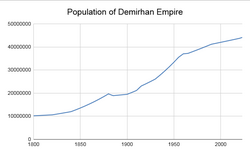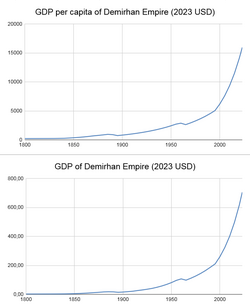Economy of Demirhan Empire
 | |||||||||||||||||||||
|---|---|---|---|---|---|---|---|---|---|---|---|---|---|---|---|---|---|---|---|---|---|
| Economy of Demirhan Empire | |||||||||||||||||||||
| Dirigist economy | |||||||||||||||||||||
| Currency | lira | ||||||||||||||||||||
| Monetary authority | Demirhan Central Bank | ||||||||||||||||||||
| GDP (PPP) | 2024 | ||||||||||||||||||||
| • Total | $2112.80 billion | ||||||||||||||||||||
| • Per capita | $40397 | ||||||||||||||||||||
| GDP (nominal) | 2024 | ||||||||||||||||||||
| • Total | $1103.22 billion | ||||||||||||||||||||
| • Per capita | $21094 | ||||||||||||||||||||
| HDI (2024) | very high | ||||||||||||||||||||
| Unemployment rate | 8.9 | ||||||||||||||||||||
| Principal exports | apples, grains, raw materials, military equipment | ||||||||||||||||||||
| Principal imports | electronics, cars | ||||||||||||||||||||
Industries and sectors | |||||||||||||||||||||
| |||||||||||||||||||||
| Exports Main export partners Imports Main import partners | |||||||||||||||||||||
| Wealth inequality index | medium | ||||||||||||||||||||
Demirhan Empire is one of the largest economies in the world and a developed country. Main pillars of the economy include tourism and other services, as well as heavy industry, followed by agriculture which becomes less important every year. While describing general policies of the country it is dirigist economy with limited access of foreign companies, especially outside ASUN. That policy, started in early 1960s allowed to create strong domestic industrial base which resulted in relatively slow but stable growth of gross domestic product. Strategical parts of the industry, such as elictricity, mining and production of weapons is owned exclusively by the government because of safety purposes.
Demographic outlook
Demirhan Empire is multiethnic country with relatively young and growing population. Most of the population lives in core part of the empire in the shores of Iviran Sea and only 8.5% lives in overseas territories. The shortened table about ethnic affiliation of population in various parts of the empire can be found in table below:
| Name | In Demirhan Empire | In Tarephian Khedivate | Total |
|---|---|---|---|
| Turquese | 33 132 896 (67.61%) | 1 688 348 (51.28%) | 34 821 244 (66.58%) |
| Sherkmans | 1 916 869 (3.91%) | 1 953 (0.06%) | 1 918 822 (3.67%) |
| Yughuts | 889 777 (1.87%) | 604 (0.02%) | 890 381 (1.87%) |
| İbrıyıms | 1 787 162 (3.68%) | 19 200 (0.58%) | 1 806 362 (3.45%) |
| Aryans | 3 224 105 (6.58%) | 338 465 (10.28%) | 3 562 570 (6.81%) |
| Antharians | 1 453 771 (2.97%) | 302 (0.01%) | 1 454 073 (2.78%) |
| Hellanesians | 1 340 993 (2.74%) | 26 217 (0.80%) | 1 367 210 (2.61%) |
| Kalmians | 70 287 (0.14%) | 217 (0.01%) | 61 504 (0.13%) |
| Lorantians | 4 255 515 (8.68%) | 26 992 (0.82%) | 4 282 507 (8.19%) |
| Malesorians | 859 676 (1.75%) | 556 (0.02%) | 860 232 (1.64%) |
| Illimans | 18 496 (0.04%) | 984 760 (29.91%) | 1 003 256 (1.92%) |
| Apurimaks | 10 934 (0.02%) | 117 124 (3.56%) | 128 058 (0.24%) |
| Other | 198 156 (0.40%) | 87 867 (2.67%) | 286 023 (0.55%) |
Economic outlook
Agriculture
Large size and diverse climate of Demirhan Empire, creates good environment for development of agriculture. Since 70s of previous century agriculture became more and more mechanised with many farming machines and tractors produced domestically. In core part of the country small farms dominate, while in Tarephian Khedivate larger farms with colonial characteristics are more common.
Spanning from cold to hot climate Demirhan Empire produces many types of crops and fruits. In continental part typical crops include wheat, cotton and oat. This is followed by fruits like apples, plums and cherries and, in warmer parts of the country, apricots and peaches. Demirhan Empire is also major producer of tomatoes and sugar beets.
In Tarephian Khedivate rice is most popular crop, followed by local subspecies of potatoes. Other farmed plants include sugar cane, tobacco, coffee beans and mangoes.
Most popular livestock are sheep (only in core part) and various races of cattle and poultry. In Tarephian Khedivate also guinea pigs are popular farm animals.
Industry
Demirhan Empire is an industrialised country. Vehicle and machine industry is well-developed, including worldwide known Vehikar, as well as several foreign brands. Other important branches of industry include chemical industry and mining. Military oriented industry also plays important role in the economy. Civil shipbuilding is based in Victoria, while military shipyard is located in Malazıt. Electronic industry negligible.
Ores are melted domestically. Typical minerals mined in Demirhan Empire include coal, copper, iron, chrome, gold and in Tarephia also molybdenum and lithium. Demirhan Empire also exploits some uranium and silver mines. In Malesorian Vilayet and Yevercin Vilayet rafineries and gas fields are also present, the fuels are produced only in small amounts for domestic needs and are unavailable on international market.
Energetic mix of the empire is based mainly on coal and gas, followed by hydroelectric and nuclear power (one experimental reactor near Kayramtor). Renewable resources other than water are negligible although interest in solar panels is growing.
Road and rail infrastructure is not very well developed but sufficient for industrial needs.
Services
One of the pillars of Demirhan Empire economy is tourism. Millions of tourists arrive yearly to see the former sultan palace in Ardeşehir, as well as sandy beaches of Sahil Eyalet and Sugar Cane Islands.
Banking sector well-developed with one state owned bank and many private banks of domestic and foreign origin. Since 1837 the empire has own stock market.
Economic data and perspectives
Gross Domestic Product of the empire grows constantly from the crisis in early 60s, although it still remains one of the poorer countries in West Uletha. The unemployment is relatively high (although lowering) with results as high as 9.8% and 8.9%. The situation is hard to change as the workforce still grows year by year as well as because of cultural reasons. On the other hand Demirhan population is not affected yet by aging and its negative consequences so costs of work are relatively low and attractive for foreign companies.
Other challenge for current and next governments is high inequality with rich cities and relatively poor rural population, especially in the west of the country.
Gross regional product
| № | Name | Gross regional product per capita [$] | Total gross regional product [billion $] | Comparison to GDP [%] | Part of GDP [%] |
|---|---|---|---|---|---|
| 1 | Ardeşehir Eyaleti | 56 025 | 818.002 | 138.68 | 38.72 |
| 2 | Payitaht Eyaleti | 51 627 | 274.874 | 127.80 | 13.01 |
| 3 | Lorantis Talamı | 48 516 | 213.068 | 120.10 | 10.08 |
| 4 | Şneldorf Vilayeti | 38 166 | 2.628 | 94.48 | 0.12 |
| 5 | Kıran Eyaleti | 37 415 | 132.044 | 92.62 | 6.25 |
| 6 | Sahil Eyaleti | 37 052 | 138.691 | 91.72 | 8.39 |
| 7 | Kan Vadisi Eyaleti | 32 182 | 93.460 | 79.66 | 4.42 |
| 8 | Şekerkamışı Vilayeti | 31 456 | 7.612 | 77.87 | 0.36 |
| 9 | Batı Karadolu Eyaleti | 28 421 | 90.195 | 70.35 | 4.27 |
| 10 | Şirvan Ostanı | 27 651 | 82.200 | 68.45 | 3.89 |
| 11 | Fırtına Burnu Vilayeti | 27 207 | 65.557 | 67.35 | 3.10 |
| 12 | Doğu Karadolu Eyaleti | 26 263 | 70.558 | 65.01 | 3.34 |
| 13 | Zorlayıcı Dağları Mahosı | 25 252 | 22.049 | 62.51 | 1.04 |
| 14 | Yevercin Vilayeti | 20 726 | 26.536 | 51.31 | 1.26 |
| 15 | Melesür Vilayeti | 20 172 | 14.967 | 49.93 | 0.71 |
| 16 | Raha Vilayeti | 19 487 | 12.571 | 48.24 | 0.59 |
| 17 | Kuruvadi Eyaleti | 17 762 | 42.952 | 43.97 | 2.03 |
| 18 | Koşangar Uçbeyliği | 16 525 | 4.948 | 40.91 | 0.23 |
Territory-specific topics
| ||||||
Regional topics
| ||||||
Global topics
| ||||||

